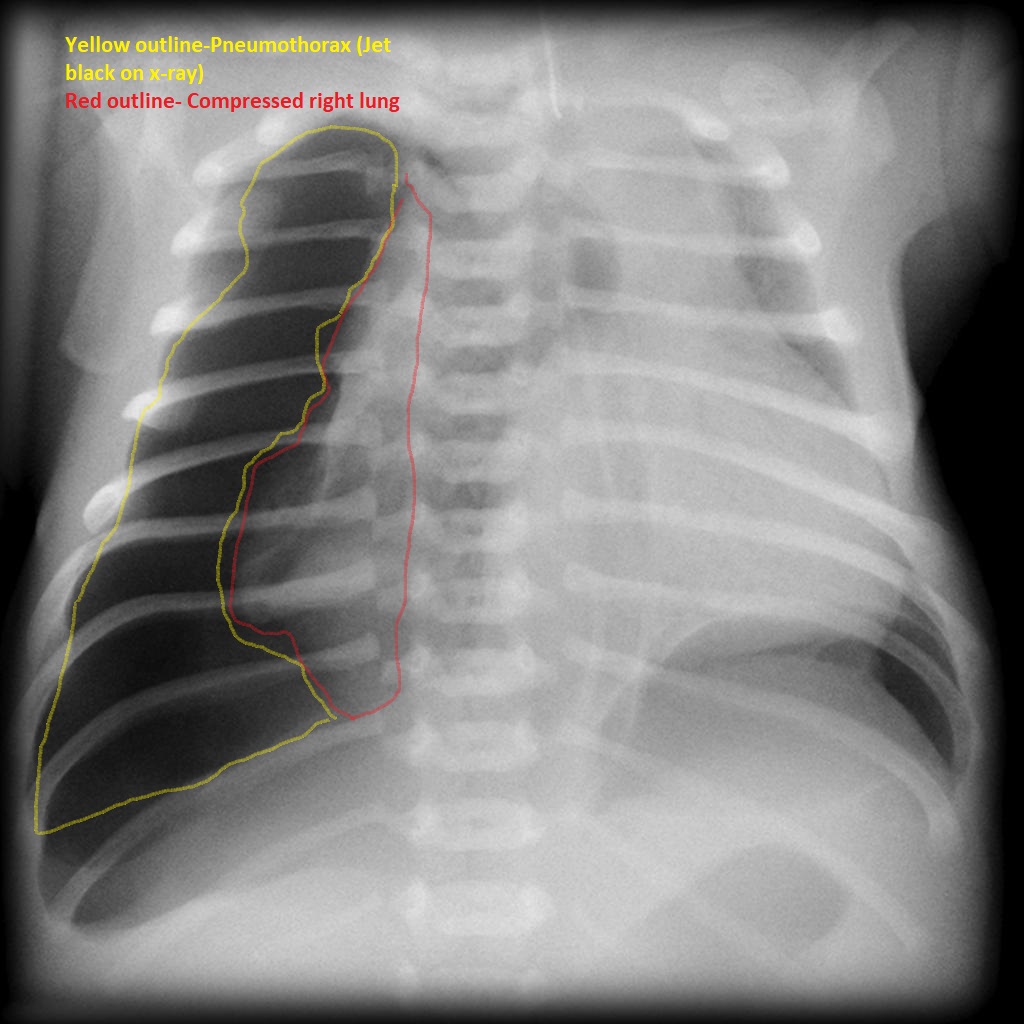Pneumothorax chest x ray: Difference between revisions
Hamid Qazi (talk | contribs) No edit summary |
Hamid Qazi (talk | contribs) No edit summary |
||
| Line 5: | Line 5: | ||
==Overview== | ==Overview== | ||
A chest x-ray may be helpful in the diagnosis of pneumothorax. Findings on an x-ray suggestive of pneumothorax include absent lung markings, white pleural lines, mediastinal shift to the opposite side, atelectasis, air fluid levels in pleural space, and deep sulcus sign. X-ray challenges for pneumothorax include air trapped between chest wall and arm will be seen as a lucency rather than a visceral pleural white line, scapula edge should be followed to make sure it does not project over chest, skin fold appear thicker than the thin visceral pleural white line, and emphysematous bullae | A [[Chest X-ray|chest x-ray]] may be helpful in the diagnosis of pneumothorax. Findings on an [[X-rays|x-ray]] suggestive of pneumothorax include absent [[lung]] markings, white [[Pleural cavity|pleural]] lines, [[Mediastinum|mediastinal]] shift to the opposite side, [[atelectasis]], air fluid levels in [[Pleural cavity|pleural]] space, and [[deep sulcus sign]]. [[X-rays|X-ray]] challenges for pneumothorax include air trapped between [[Thoracic cavity|chest wall]] and arm will be seen as a lucency rather than a [[Viscus|visceral]] [[Pleural cavity|pleural]] white line, [[scapula]] edge should be followed to make sure it does not project over [[chest]], skin fold appear thicker than the thin [[Viscus|visceral]] [[Pleural cavity|pleural]] white line, and emphysematous bullae can be seen as convexity laterally. | ||
==X Ray== | ==X Ray== | ||
*An x-ray may be helpful in the diagnosis of pneumothorax. Findings on an x-ray suggestive of pneumothorax include:<ref name="SharmaJindal2008">{{cite journal|last1=Sharma|first1=Anita|last2=Jindal|first2=Parul|title=Principles of diagnosis and management of traumatic pneumothorax|journal=Journal of Emergencies, Trauma and Shock|volume=1|issue=1|year=2008|pages=34|issn=0974-2700|doi=10.4103/0974-2700.41789}}</ref> | *An [[X-rays|x-ray]] may be helpful in the diagnosis of pneumothorax. Findings on an [[X-rays|x-ray]] suggestive of pneumothorax include:<ref name="SharmaJindal2008">{{cite journal|last1=Sharma|first1=Anita|last2=Jindal|first2=Parul|title=Principles of diagnosis and management of traumatic pneumothorax|journal=Journal of Emergencies, Trauma and Shock|volume=1|issue=1|year=2008|pages=34|issn=0974-2700|doi=10.4103/0974-2700.41789}}</ref> | ||
**Absent lung markings | **Absent [[lung]] markings | ||
**White pleural lines | **White [[Pleural cavity|pleural]] lines | ||
**Mediastinum shift to the opposite side | **[[Mediastinum]] shift to the opposite side | ||
**Atelectasis | **[[Atelectasis]] | ||
**Air fluid level in pleural space | **Air fluid level in [[Pleural cavity|pleural]] space | ||
**Outline of diaphragm under the heart | **Outline of [[Thoracic diaphragm|diaphragm]] under the heart | ||
**Deep sulcus sign | **[[Deep sulcus sign]] | ||
**Increased rib separation | **Increased rib separation | ||
**Ipsilateral flattening of heart border | **Ipsilateral flattening of [[heart]] border | ||
**Midiaphragmatic depression | **Midiaphragmatic [[depression]] | ||
===X-Ray challenges=== | ===X-Ray challenges=== | ||
*Skin fold appear thicker than the thin visceral pleural white line | *Skin fold appear thicker than the thin [[Viscus|visceral]] [[Pleural cavity|pleural]] white line | ||
*Air trapped between chest wall and arm will be seen as a lucency rather than a visceral pleural white line | *Air trapped between [[Thoracic cavity|chest wall]] and arm will be seen as a lucency rather than a [[Viscus|visceral]] [[Pleural cavity|pleural]] white line | ||
*Follow scapula edge to make sure it does not project over chest | *Follow [[scapula]] edge to make sure it does not project over chest | ||
*Emphysematous bullae seen as convexity laterally | *Emphysematous bullae seen as convexity laterally | ||
Latest revision as of 00:32, 20 February 2018
|
Pneumothorax Microchapters |
|
Diagnosis |
|---|
|
Treatment |
|
Case Studies |
|
Pneumothorax chest x ray On the Web |
|
American Roentgen Ray Society Images of Pneumothorax chest x ray |
|
Risk calculators and risk factors for Pneumothorax chest x ray |
Editor-In-Chief: C. Michael Gibson, M.S., M.D. [1]; Associate Editor(s)-in-Chief: Hamid Qazi, MD, BSc [2]
Overview
A chest x-ray may be helpful in the diagnosis of pneumothorax. Findings on an x-ray suggestive of pneumothorax include absent lung markings, white pleural lines, mediastinal shift to the opposite side, atelectasis, air fluid levels in pleural space, and deep sulcus sign. X-ray challenges for pneumothorax include air trapped between chest wall and arm will be seen as a lucency rather than a visceral pleural white line, scapula edge should be followed to make sure it does not project over chest, skin fold appear thicker than the thin visceral pleural white line, and emphysematous bullae can be seen as convexity laterally.
X Ray
- An x-ray may be helpful in the diagnosis of pneumothorax. Findings on an x-ray suggestive of pneumothorax include:[1]
- Absent lung markings
- White pleural lines
- Mediastinum shift to the opposite side
- Atelectasis
- Air fluid level in pleural space
- Outline of diaphragm under the heart
- Deep sulcus sign
- Increased rib separation
- Ipsilateral flattening of heart border
- Midiaphragmatic depression
X-Ray challenges
- Skin fold appear thicker than the thin visceral pleural white line
- Air trapped between chest wall and arm will be seen as a lucency rather than a visceral pleural white line
- Follow scapula edge to make sure it does not project over chest
- Emphysematous bullae seen as convexity laterally

References
- ↑ Sharma, Anita; Jindal, Parul (2008). "Principles of diagnosis and management of traumatic pneumothorax". Journal of Emergencies, Trauma and Shock. 1 (1): 34. doi:10.4103/0974-2700.41789. ISSN 0974-2700.